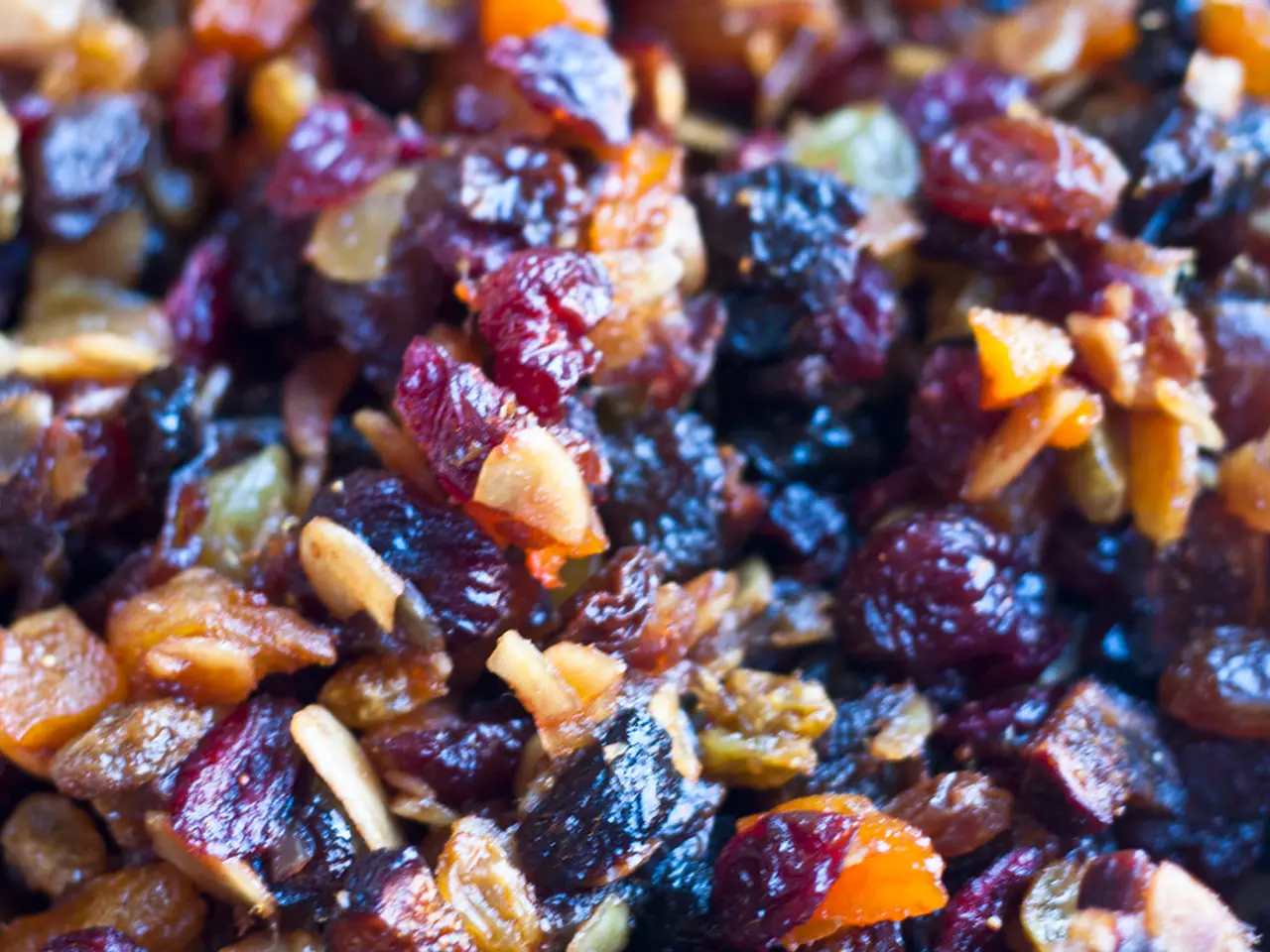Diet with Reduced Sodium and Cholesterol: Identifying Suitable Foods and Those to Limit
A low sodium, low cholesterol diet is an effective way to maintain a healthy heart and reduce the risk of heart disease. This diet emphasizes fresh, minimally processed foods with lean proteins, whole grains, fruits, vegetables, and heart-healthy fats, while avoiding processed meats, high-fat dairy, added salts, and processed snacks.
Foods to Include
- Fresh fruits and vegetables: Naturally low in sodium and cholesterol, these foods are high in fiber and nutrients.
- Whole grains: Opt for whole-grain breads, brown rice, and pasta without added salt.
- Lean proteins: Include fish, such as salmon, cod, halibut, and catfish, which are low in sodium and rich in heart-healthy omega-3 fats. Other lean protein sources are skinless chicken or turkey breast, and legumes like beans, lentils, and peas.
- Nuts: Walnuts and other unsalted nuts offer healthy fats and protein without cholesterol.
- Low-fat dairy: Choose low-fat or nonfat options to reduce saturated fat and cholesterol intake.
- Low sodium condiments: Use herbs, dill, lemon, Dijon mustard (in moderation), and other non-salty seasonings to boost flavor without increasing sodium.
Foods to Avoid or Limit
- Processed and ultra-processed foods: These often contain high sodium and unhealthy fats. Examples include chips, pretzels, popcorn, frozen dinners, fast food, and packaged snacks.
- Processed meats: Bacon, sausage, cold cuts, and ham are high in sodium and cholesterol.
- Full-fat dairy products: Butter, whole milk, cheese, and cream contain high saturated fat and cholesterol.
- Fatty cuts of meat: Pork belly and heavily marbled beef or pork should be avoided. Instead, choose lean cuts like pork tenderloin with trimmed fat.
- Canned foods with added salt: Many canned vegetables, soups, and broths are high in sodium unless labeled low sodium.
- Certain condiments: Ketchup, barbeque sauce, and many commercial sauces are typically high in sodium.
Additional Recommendations
- Avoid fried foods, such as french fries, potato chips, and fried chicken.
- Limit desserts, such as ice cream, pudding, and pies.
- Eating a diet high in saturated fats and trans fats may result in high LDL cholesterol levels, which can build up in the arteries and increase a person's risk of blood clots, high blood pressure, and heart disease.
- Saturated vegetable oils, such as palm oil, coconut oil, and palm kernel oil, should be avoided.
- A low sodium, low saturated fat diet is recommended to reduce the amount of "bad" cholesterol (LDL) in the blood and lower the risk of high blood pressure.
- High total cholesterol is a reading of 240 milligrams per deciliter (240 mg/dL) or higher. Doctors consider total cholesterol of 200-239 mg/dL borderline high.
- The American Heart Association (AHA) recommends consuming no more than 2,300 milligrams (mg) of sodium per day, which is equivalent to 1 teaspoon.
- Organ meat, such as kidney and liver, should be avoided on a low cholesterol diet.
- To maintain a healthy total cholesterol level under 200 mg/dL, doctors usually recommend a diet low in saturated fat and cholesterol.
- The low sodium, low cholesterol diet is particularly beneficial for people with high blood pressure and high blood cholesterol levels, as it can decrease the risk of heart disease, heart attack, and stroke.
- The diet emphasizes whole, minimally processed foods, and people should compare nutrition fact labels and choose options with lower sodium, saturated fat, and added sugar.
- Increasing physical activity is recommended to reduce "bad" cholesterol and increase the levels of "good" HDL cholesterol in the body.
- The cholesterol in food has very little effect on blood cholesterol, and the focus is now on limiting saturated fats and trans fats.
- Baked food products, such as cakes, cookies, crackers, pastries, and donuts, should be limited.
- Stopping smoking can yield long-term benefits for a person's cholesterol levels and lower their risk of heart disease.
- Avoiding fatty cuts of red meat, such as beef, lamb, pork, and poultry, is recommended for people with high cholesterol.
- Full-fat dairy, including butter, whole milk, cheese, and full-fat yogurt, should be limited.
- The guidelines recommend limiting saturated fats to less than 6% of total calories, while the 2020-2025 Dietary Guidelines for Americans recommends 10%.
- This low sodium, low cholesterol diet aims to maintain heart health and reduce the risk of heart disease.
- The diet promotes fresh fruits and vegetables, which are high in fiber and nutrients but low in sodium and cholesterol.
- Whole grains are also emphasized, with options like whole-grain breads, brown rice, and pasta suggested.
- Lean proteins, such as fish and skinless chicken or turkey breast, are included due to their low sodium and cholesterol content.
- Nuts, like walnuts, offer healthy fats and protein without cholesterol.
- Low-fat dairy is another recommended food, with low-fat or nonfat options reducing saturated fat and cholesterol intake.
- Non-salty seasonings, such as herbs, dill, and lemon, are used to boost flavor without increasing sodium.
- Processed and ultra-processed foods, including chips, pretzels, and packaged snacks, should be avoided due to their high sodium and unhealthy fats.
- Processed meats, like bacon, sausage, cold cuts, and ham, are high in sodium and cholesterol and should be limited.
- Full-fat dairy products, such as butter, whole milk, cheese, and cream, contain high saturated fat and cholesterol and should be avoided.
- Fried foods, like french fries, potato chips, and fried chicken, should also be avoided due to their high saturated fat content.
- To maintain a healthy cholesterol level, one should limit saturated fats and trans fats, such as those found in palm oil, coconut oil, and palm kernel oil.
- To reduce LDL cholesterol levels and lower the risk of high blood pressure, a low sodium, low saturated fat diet is recommended.
- High total cholesterol (240 mg/dL or higher) and borderline high total cholesterol (200-239 mg/dL) increase the risk of blood clots, high blood pressure, and heart disease.
- The American Heart Association recommends no more than 2,300 mg of sodium per day, equivalent to 1 teaspoon.
- Organ meat, such as kidney and liver, should be avoided on a low cholesterol diet.
- To maintain a healthy total cholesterol level under 200 mg/dL, a diet low in saturated fat and cholesterol is usually recommended.
- The diet is particularly beneficial for those with high blood pressure and high blood cholesterol levels, helping to decrease the risk of heart disease, heart attack, and stroke.
- To further support heart health and overall health-and-wellness, one should also focus on fitness-and-exercise and adopt healthy-diets rich in nutrient-dense foods, whole grains, lean proteins, fruits, vegetables, and heart-healthy fats.
- As some medical-conditions, such as high blood pressure, hypertension, and other heart diseases, can be chronic, it's essential to establish and maintain healthy habits like a low sodium, low cholesterol diet, fitness-and-exercise, and a healthy-diet for sustainable cardiovascular-health.
- The science behind a low sodium, low cholesterol diet is supported by medical research, making it a contextual choice for maintaining a healthy heart and overall health.
- By retargeting one's diet to exclude unhealthy foods like processed meats, high-fat dairy, added salts, and processed snacks, and include healthier options like fresh fruits, vegetables, lean proteins, whole grains, heart-healthy fats, and low sodium condiments, one can observe improvements in cardiovascular-health, cholesterol levels, and overall health-and-wellness.






